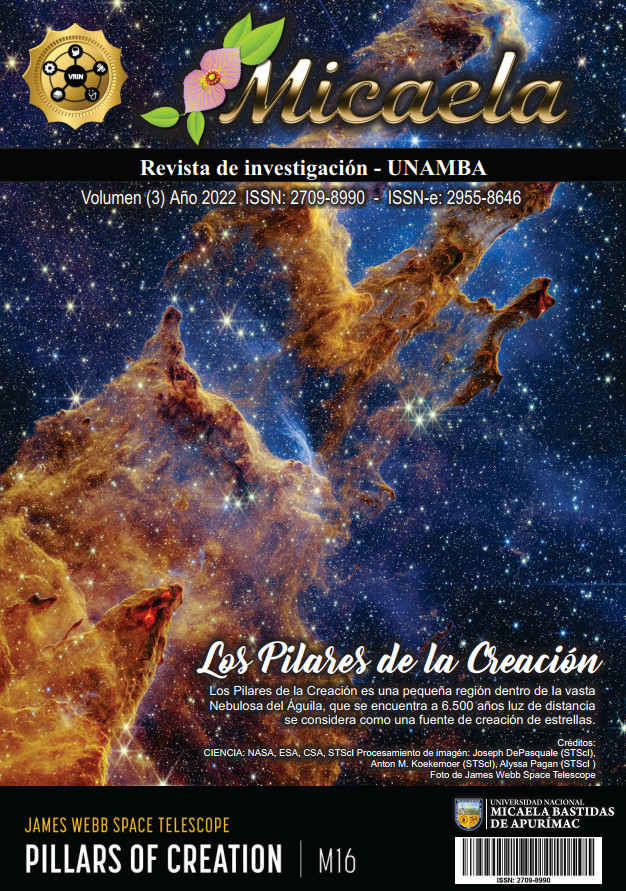Porous concrete tested in rains of the tracks of the district of Abancay
Main Article Content
Abstract
The research project arose from the unknowns, such as understanding the physical and mechanical properties of porous concrete tested in rain on runways in the Abancay district. Its objectives are to establish the compressive stability, modulus of rupture, and evaluate the absorption of porous concrete, using standard practice guidelines for selecting proportions for normal concrete. This guideline assists in the development of porous concrete with compressive stability (f¨c = 210 kg/cm2) with 12, 17, and 22% voids. Conclusions: The T1 procedure with 12% void of Spindle 8 has greater stability, approaching the level of stability required for this type of porous concrete and for the type of tracks, it has been observed that Spindle 67 is lower in resistance in each of the void percentages with respect to Spindle 8, then the T2 procedure is very important for the design of porous concrete, the modulus of rupture of the T1 procedures of 12% void and T2 at 17% void of Spindle 8 is not significantly different, however T1 is different from T3 of 22% void percentage of Spindle 8 and 67. Then the treatment is adequate.
Article Details

This work is licensed under a Creative Commons Attribution-NonCommercial-ShareAlike 4.0 International License.
Los nombres y las direcciones de correo electrónico introducidos en esta revista se usarán exclusivamente para los fines establecidos en ella y no se proporcionarán a terceros o para su uso con otros fines.
How to Cite
References
Abanto Castillo, F.: Tecnología del concreto. San Marcos. Lima-Perú: s.n. ISBN 9786123020606 (2009).
Cardona Maldonado, H.A., Propiedades Mecánicas y de filtración en hormigones permeables con ce-mento portland e hidráulicos, vol. I, pp. 130. (2017).
Castañeda, L., Moujir, Y., Diseño y aplicación de concreto poroso para pavimentos. Pontificia Univer-sidad Javeriana, Facultad de Ingeniería (2014).
Fernández, A., Carro, A.: Diseño de mezclas para evaluar su Resistencia a la compresión uniaxial y su permeabilidad. Infraestructura vial, vol. I, N° XXIX, pp. 40-49 (2011).
Vélez, L.M., 2010b. Permeabilidad y Porosidad en Concreto. (2010).
https://doi.org/10.22430/22565337.131
Cabello Sequera, S., Campuzano Vera, L., Espinoza Correa, J. y Sánchez Mendieta, C., 2015. Concreto Poroso: Constitución, variables influyentes y protocolos para su caracterización. Cumbres Revista Cien-tífica, vol. 1, pp. 64-69. ISSN 1390-9541
https://doi.org/10.48190/cumbres.v1n1a9
Cerdán Pérez, L.A.,2015. Comportamiento del concreto permeable, utilizando agregado de las canteras la Victoria y Roca Fuerte, aumentando diferentes porcentajes de vacíos, Cajamarca 2015. S.I.: Universi-dad Privada del Norte.
Díaz Silva, N.Y., 2017. Diseño de mezcla de concreto permeable elaborado con aditivo y adición de fi-bra de polipropileno para uso en pavimentos, en la ciudad de Cajamarca. S.I.: Universidad Nacional de Cajamarca. Facultad de Ingeniería.
López Palacio, E., 2010. Control de Calidad y colocación de concretos permeables. Tesis.
MTC, 2016. Manual de ensayo de materiales, vol. I, pp.1272.
Ortega Moreno, A.M., 2015. Estudio de una mezcla en concreto con estructura drenante fabricado con agregados de las fuentes de abastecimiento del municipio. S.I.: Universidad de Nariño.






